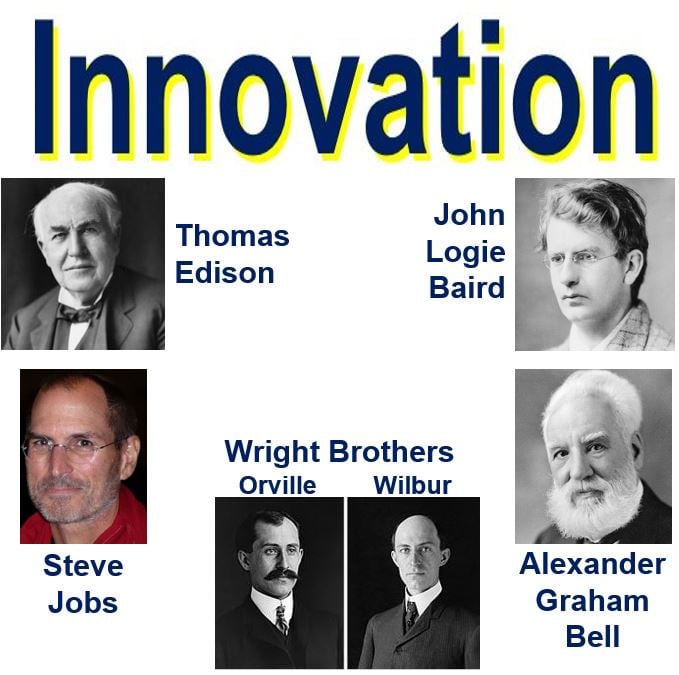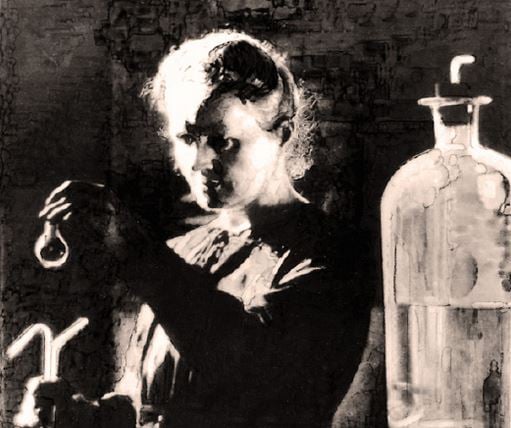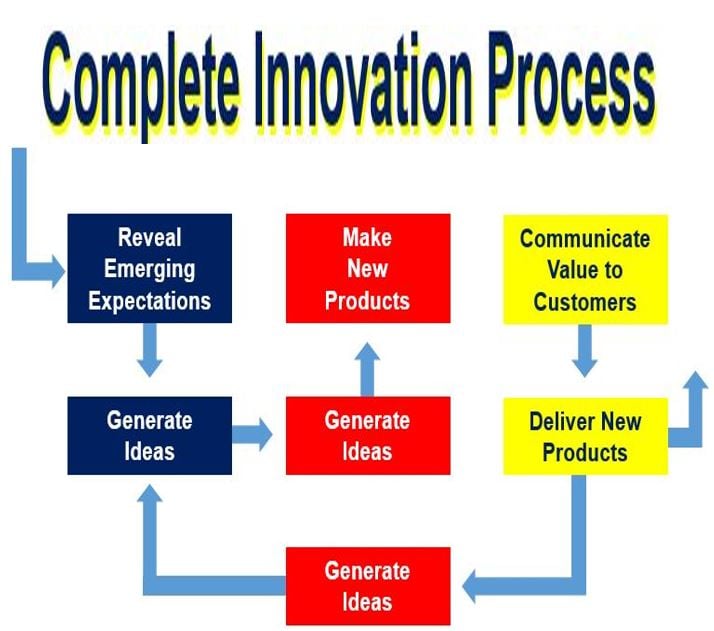Innovation – definition and meaning
Innovation means thinking of and creating new ways of doing things. It is an important part of many successful businesses. Bringing innovation into your company can help save money and time. It can also give the business a competitive edge in the marketplace.
According to business.gov.au, part of the Australian Government, innovation may refer to creating new products and ideas. It may also refer to improving or creating more effective processes.
For a commercial enterprise, this might mean implementing new ideas, improving existing services, or creating dynamic products.
Consumer technology companies regularly introduce upgrades and new features to their existing products. We call this strategy incremental innovation.
 The innovations of these inventors dramatically changed the behavior and lifestyles of most of the world’s population. Thomas Edison with the light bulb. Steve Jobs created the Mac, iPod, iPhone & iPad The Wright brothers brought flight. Alexander Graham Bell invented the telephone. John Logie Baird created the first television.
The innovations of these inventors dramatically changed the behavior and lifestyles of most of the world’s population. Thomas Edison with the light bulb. Steve Jobs created the Mac, iPod, iPhone & iPad The Wright brothers brought flight. Alexander Graham Bell invented the telephone. John Logie Baird created the first television.
It can help trigger growth and make the business more successful. Innovation may also make the business better able to adapt and thrive in the changing marketplace.
There is more to being innovative than just inventing, although it is a major feature. Somebody who changes his company’s business model is innovative. So is a management team that successfully adapts its firm to its environment so that it can better deliver products. The company subsequently generates more revenue.
All companies that innovate have some things in common. They have more efficient work processes, superior performance, and better productivity, compared to their non-innovative competitors.
According to the Financial Times Lexicon, innovation:
“Involves producing new products and services, new business models, and new or improved methods for producing goods or services. Innovation is more than invention. It feeds commercial success, normally boosting efficiency and/or profits.”
According to Diffusion of Innovations theory, innovators are the first people to adopt a new product or system. The last people are laggards.
 Marie Skłodowska Curie (1867-1934) was a Polish-born, French physicist and chemist who received the Nobel Prize twice. We remember her for her discovery of radium and polonium, and her enormous contribution to the fight against cancer. She also defined the theory of radioactivity, a discovery that eventually killed her. She died from aplastic anemia, which she probably contracted from her long-term exposure to radiation. (Image: mariecurie.org.uk/who)
Marie Skłodowska Curie (1867-1934) was a Polish-born, French physicist and chemist who received the Nobel Prize twice. We remember her for her discovery of radium and polonium, and her enormous contribution to the fight against cancer. She also defined the theory of radioactivity, a discovery that eventually killed her. She died from aplastic anemia, which she probably contracted from her long-term exposure to radiation. (Image: mariecurie.org.uk/who)
To qualify as innovation
Innovation refers to the process of turning an idea or invention into something that creates value and for which consumers are willing to pay.
For something to qualify as an innovation, an idea must be replicable and economically viable. It must also satisfy a specific need. ‘Viable,’ in the world of business, means ‘capable of making a profit year after year.’
Innovation in business typically results when a company responds to customer needs and expectations with new ideas. It responds because it wants to satisfy its consumers further.
Sometimes, we may class getting rid of something as innovation. For example, discontinuing an out-of-date or inefficient service, process, or service may be an innovative move.
Product innovation
Goods that replace or build on current offerings, provide new features or other advantages that allow users to operate less expensively or more efficiently are innovative products.
For example, the computer mouse, GPS navigation systems, the iPod, and the motor car were innovative products. The electric light bulb is also an example of innovation.
The American Society for Quality says that these innovative products introduced radically new choices for customers. Demand for them in the global marketplace grew dramatically and made sizable profits for their makers.
 Having an innovation system within a company is crucial if it wants ideas to make it to the market. According to markproffitt.com: “The reason 88% of ideas fail to make it to market is companies have no system to turn ideas into marketable innovations. Even though 87% of CEOs list innovation as a Top 5 priority 78% of companies have no innovation system.”
Having an innovation system within a company is crucial if it wants ideas to make it to the market. According to markproffitt.com: “The reason 88% of ideas fail to make it to market is companies have no system to turn ideas into marketable innovations. Even though 87% of CEOs list innovation as a Top 5 priority 78% of companies have no innovation system.”
Process innovation
The product might be a staple with a long product life cycle, or a commodity. It might also be something we all consume such as milk, flour, or bread.
For competitiveness and long-term success, innovation is still crucial. Improving the manufacturing or delivery processes, and thus offering greater value to customers, are examples of innovation.
Half a century ago, there was usually someone at home during the daytime, so delivering milk door-to-door worked fine. There are too many households today with nobody in them during typical working hours. Therefore, home delivery is an out-of-date system for people who want milk that has not turned sour.
 Winston Churchill once said: “Without tradition, art is a flock of sheep without a shepherd. Without innovation, it is a corpse.” (Image: churchillcentral.com)
Winston Churchill once said: “Without tradition, art is a flock of sheep without a shepherd. Without innovation, it is a corpse.” (Image: churchillcentral.com)
Distributors of milk made their product available at grocers and quick-stop stores. This allowed consumers to pick up the milk in a way that suited their lifestyles. Today, people can order their milk online and have it delivered when they are at home.
French chemist and microbiologist Louis Pasteur (1822-1895) invented the process of pasteurization. His invention which made milk last longer. Pasteur’s process innovation, and some others, such as making milk available in powdered form, benefited customers and retailers.
Process innovation looks at how we make and deliver an existing product.
 Bill Gates, co-founder of Microsoft, once said: “The tool that’s most associated with the recent progress against malaria is the long-lasting bed net. Bed nets are a fantastic innovation. But we can do even better. We can invent new ways to control the mosquitoes that carry the malaria parasite.” (Image: twitter.com/billgates)
Bill Gates, co-founder of Microsoft, once said: “The tool that’s most associated with the recent progress against malaria is the long-lasting bed net. Bed nets are a fantastic innovation. But we can do even better. We can invent new ways to control the mosquitoes that carry the malaria parasite.” (Image: twitter.com/billgates)
Business model innovation
Sometimes, a company’s business model becomes obsolete. To survive, it needs new ideas.
Innovation may involve radical changes to the whole structure of a business. Organizations that provide care are having to change and adapt rapidly. This is because the use of home care is growing while hospitalized care is shrinking.
In a rapidly-changing market, companies without business model innovation do not survive. However, those with business model innovation are more likely to prevail and even thrive.
In the past, people delivered newspapers to shops and door-to-door. In those days, we only had newspaper printed on paper. People paid money for a newspaper and businesses, individuals and other organizations advertised in them. In fact, that was how newspapers generated revenue.
Today, printed-paper newspapers still exist. However, a rapidly-growing number of people no longer read them. They get all their news from the Internet.
Online newspapers can charge for access, and can also generate income from advertisers. However, advertisers want much more information today than simply how many readers a newspaper has.
Advertisers want metrics. In other words, they want to know how many people each day saw their ads and how many clicked on them. They also want to know where these people are, what socioeconomic groups they belong to, etc.
Modern newspapers that do not adapt to these customer needs rapidly lose out to competitors that do adapt.
Many management consultants say that novel ideas are more like to come with ‘out of the box thinking.’ This means thinking in non-conventional ways.
For innovation to be successful, there must be a gap in the market. In other words, there must be potential demand for a new product that does not exist yet.
Video – What is innovation?
This National Science Foundation video explains what innovation is.

